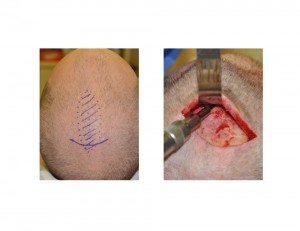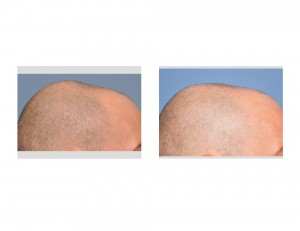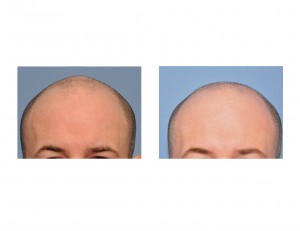Background: The shape of one’s head often takes a second place to that of the face. After all the head is but a backdrop onto which the face projects. Given that hair usually adorns most of the head’s surface, any shape issues are fairly well camouflaged. In certain skull shapes even good hair density may not be enough to hide it and may even accentuate it in some cases. Hair loss, of course, exposes any abnormality in skull shape and may tip the balance toward an interest in change.
One of the classic skull deformities is that of the sagittal crest or sagittal ridge deformity. This head shape is seen as a raised ridge or crest in the midline. It often starts behind the frontal hairline and reaches its highest near the back of the head. This creates a peaked or crestal appearance to the head shape. It is caused by some mild aberration of the sagittal suture where excess bone piles up along its course making it thicker. It is not a true sagittal craniosynostosis but probably some minor variation of it.
In the animal world, the presence of sagittal crest in the skull is common and usually indicates that the animal has very strong jaw muscles and a powerful bite force. The attachment of the temporal muscles due to their size migrates to the midline during development, creating a single midline temporal line rather than the more lateral paired temporal lines seen in humans. This is seen in a wide variety of animals from dogs, apes and even dinosaurers. Perhaps this is why the sagittal crest is undesired in humans since it is an animal feature.
Case Study: A 30 year-old male wanted to improve the shape of his head. He had a prominent ridge on the back half of his head. It was raised up in the midline creating a visible sagittal ridge. He basically shaved his head so there was no hiding this raised area of the skull.



Case Highlights:
1) The sagittal crest skull deformity is marked by a midline ridge of varying thicknesses that is often located more to the back of the head.
2) An open burring technique can reduce a sagittal crest skull deformity up to 7mms in the midline.
3) The midline reduction must take into consideration the parasagittal bone shape to avoid a midline plateau effect.
Dr. Barry Eppley
Indianapolis, Indiana



